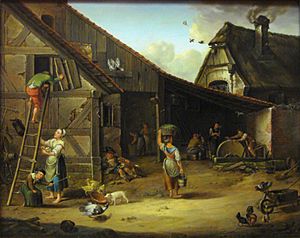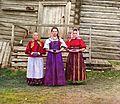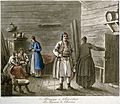Peasant facts for kids
A peasant was a person who lived and worked on a farm, usually for a wealthy landowner, especially during the Middle Ages. They often didn't have much money and wore simple clothes. They lived in small homes, often in villages in the countryside.
The word "peasant" comes from an old French word meaning "countryside." In the Middle Ages, which was around the 15th century, peasants were a huge part of the population. They had to be skilled in many different farm jobs, like planting, harvesting, and caring for animals. Most peasants could not read or write, and they usually didn't mix with richer, more powerful people unless it was for work. Some peasants were called serfs, which meant they were not free to leave the land owned by their lord.
Contents
Life as a Peasant
Life for peasants was often very hard. They worked from sunrise to sunset, especially during planting and harvesting seasons. Their daily lives revolved around the farm and the needs of their lord.
Daily Work and Responsibilities
Peasants had many jobs to do. They plowed fields, sowed seeds, and harvested crops like wheat, barley, and oats. They also cared for farm animals such as cows, sheep, and pigs. Besides farming, they might also help build or repair buildings, dig ditches, or clear land. Their work was essential for feeding everyone, from the lord to the villagers themselves.
Roles of Men and Women
Both men and women worked hard in peasant families. Men often did the heavy labor in the fields, like plowing and digging. However, women also worked in the fields, especially during busy times like harvest.
Inside the home, women usually managed the household. This included cooking meals, cleaning, making clothes from scratch, and looking after the children. They also often had small gardens to grow vegetables for the family and might raise chickens or other small animals. Everyone in the family, including children, had tasks to help with daily life.
Peasants and Feudalism
To understand peasants, it's important to know about feudalism. This was a system of organizing society that was common in Europe during the Middle Ages.
What Was Feudalism?
Feudalism was a system where land was exchanged for loyalty and service. A king or powerful lord owned vast amounts of land. They would grant parts of this land to nobles (like dukes or counts) in exchange for their military service and loyalty. These nobles, in turn, would allow peasants to live and work on their land.
The Lord-Peasant Relationship
In this system, peasants were tied to the land. They worked the lord's land, and in return, the lord offered them protection and a small plot of land for their own use. However, peasants had to give a large part of their harvest to the lord and often had to pay taxes or provide other services. For example, they might have to work on the lord's personal land for a certain number of days each week.
Serfdom: Not Free to Leave
Some peasants were called serfs. Serfs were not slaves, but they were not entirely free either. They were bound to the land, meaning they could not leave the lord's estate without his permission. If the land was sold, the serfs living on it were sold with it. Their lives were controlled by the lord, and they had very few rights. This system lasted for many centuries in different parts of the world.
Images for kids
-
Young women offer berries to visitors to their izba home, 1909. Those who had been serfs among the Russian peasantry were officially emancipated in 1861. Photograph by Sergey Prokudin-Gorsky.
-
Finnish Savonian farmers at a cottage in early 19th century; by Pehr Hilleström and J. F. Martin
-
Portrait sculpture of 18th-century French peasants by artist George S. Stuart, in the permanent collection of the Museum of Ventura County, Ventura, California
See also
 In Spanish: Campesino para niños
In Spanish: Campesino para niños






